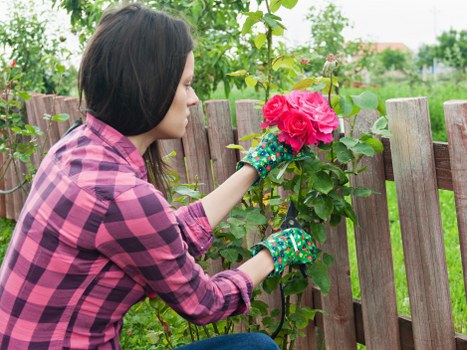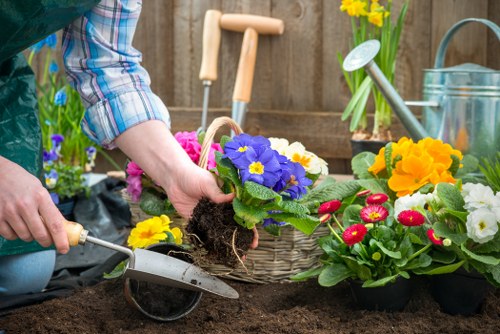Mastering Hedge Trimming in Pinner: Expert Tips and Techniques

Maintaining a beautiful garden requires regular upkeep, and one of the most essential tasks is hedge trimming in Pinner. Properly trimmed hedges not only enhance the aesthetic appeal of your property but also ensure the health and longevity of your plants. Whether you're a seasoned gardener or a homeowner looking to improve your outdoor space, understanding the nuances of hedge trimming can make a significant difference.
Hedge trimming involves more than just cutting back overgrown branches. It requires knowledge of plant biology, the right tools, and the appropriate techniques to achieve the desired shape and size. In Pinner, where the climate and soil conditions can influence plant growth, tailoring your trimming approach is crucial.
In this comprehensive guide, we'll explore the best practices for hedge trimming in Pinner, including the benefits, tools you'll need, step-by-step trimming processes, and maintenance tips to keep your hedges looking pristine all year round.

Why Hedge Trimming is Important
Enhances Curb Appeal
A well-trimmed hedge can significantly boost the curb appeal of your home. It creates a neat and orderly appearance, making your property more attractive to visitors and potential buyers. In a neighborhood like Pinner, where gardens are cherished, maintaining your hedges can set your home apart.
Besides aesthetic benefits, hedge trimming plays a vital role in plant health. Removing dead or diseased branches prevents the spread of pests and illnesses, ensuring your hedges remain vibrant and robust. Regular trimming also promotes better air circulation and sunlight penetration, essential factors for healthy plant growth.
Moreover, hedges can serve functional purposes such as providing privacy, acting as windbreaks, and defining property boundaries. Properly maintained hedges are more effective in fulfilling these roles, offering both beauty and practicality.

Essential Tools for Hedge Trimming
Having the right tools is crucial for effective hedge trimming in Pinner. Investing in quality equipment not only makes the job easier but also ensures precision and safety.
Pruning Shears
Pruning shears are essential for trimming smaller branches and shaping the edges of your hedges. Look for shears with sharp blades and comfortable grips to reduce hand fatigue during prolonged use.
Hedge Trimmers
For larger hedges, electric or gas-powered hedge trimmers can save time and effort. They allow for quick, even cuts and can handle thicker branches with ease. Ensure you choose a trimmer that suits the size and density of your hedges.
Loppers
Loppers are ideal for cutting thicker branches that pruning shears can't handle. They provide the necessary leverage to make clean cuts without damaging the plant.
- Pruning Shears
- Electric or Gas-Powered Hedge Trimmers
- Loppers
- Protective Gear (Gloves, Safety Glasses)
- Rakes and Shears Maintenance Tools

Step-by-Step Hedge Trimming Guide
Trimming hedges requires a systematic approach to achieve the best results. Follow these steps to ensure your hedges are trimmed effectively:
1. Assess the Hedge
Before you start trimming, examine the overall shape and health of your hedge. Identify any dead or diseased branches that need immediate attention.
2. Gather Your Tools
Ensure all your trimming tools are in good working condition. Sharpen blades and check for any necessary repairs to avoid interruptions during the trimming process.
3. Start with the Sides
Begin by trimming the sides of the hedge, working from the bottom to the top. Use long, even strokes to create a uniform shape. Maintain a consistent angle to ensure the hedge grows evenly.

h4>4. Trim the Top
After shaping the sides, focus on the top of the hedge. Trim it to the desired height, keeping the surface level. This step helps prevent the hedge from becoming too tall and unmanageable.
h4>5. Clean Up
Remove all trimmed branches and debris from the area. Proper cleanup not only enhances the appearance but also prevents potential pests and diseases from taking hold.
h4>6. Regular Maintenance
To keep your hedges looking their best, schedule regular trimming sessions. Depending on the growth rate, this could be quarterly or bi-annually. Consistent maintenance ensures your hedges remain healthy and well-shaped.
Tips for Effective Hedge Trimming
- Trim hedges during the growing season for optimal growth and health.
- Always use clean and sharp tools to make precise cuts.
- Wear protective gear to prevent injuries.
- Maintain a consistent shape and height throughout the trimming process.
- Water and fertilize your hedges regularly to promote healthy growth.
Common Mistakes to Avoid
Even with the best intentions, it's easy to make mistakes when trimming hedges. Avoid these common pitfalls to ensure your hedges remain healthy and attractive:
Over-Trimming
Cutting too much at once can stress the plant and inhibit growth. Aim to remove no more than one-third of the hedge's volume in a single trimming session.
Ignoring Plant Health
Failing to remove dead or diseased branches can lead to the spread of pests and diseases. Always inspect your hedges before trimming and address any health issues promptly.
Inconsistent Trimming
Avoid uneven trimming, which can result in an unbalanced appearance. Use consistent angles and follow the natural growth pattern of the hedge to maintain uniformity.
- Over-Trimming
- Ignoring Plant Health
- Inconsistent Trimming
- Using Dull or Dirty Tools
- Trimming at the Wrong Time of Year
Seasonal Hedge Trimming Tips
Different seasons require different trimming approaches to ensure the health and beauty of your hedges.
Spring
Spring is an ideal time to trim hedges as they begin their growth cycle. Focus on shaping and removing any winter damage to prepare the plants for the growing season.
Summer
In summer, regular trimming helps maintain the desired shape and prevents the hedges from becoming overgrown. Ensure adequate watering and provide partial shade if necessary to prevent stress.
Autumn
Trimming in autumn helps remove any final growth and prepares the hedges for the dormant winter period. Focus on cleaning up and ensuring good air circulation around the plants.
Winter
While winter is a quieter period for hedge trimming, minimal maintenance can help keep the hedges in good condition. Avoid heavy trimming and focus on protective measures against frost and cold damage.
- Spring: Shaping and Repair
- Summer: Regular Maintenance
- Autumn: Final Trimming
- Winter: Minimal Maintenance
Choosing the Right Plants for Your Hedge
Selecting the appropriate plants is crucial for a thriving hedge in Pinner. Consider factors such as climate, soil type, growth rate, and maintenance requirements when choosing hedge plants.
Popular Hedge Plants in Pinner
- Boxwood (Buxus)
- Privet (Ligustrum)
- Laurel (Prunus laurocerasus)
- Yew (Taxus)
- Holly (Ilex)
Each of these plants has unique characteristics that make them suitable for different hedge styles and purposes. For instance, Boxwood is excellent for formal hedges due to its dense foliage and ease of shaping, while Privet offers fast growth and adaptability.
Factors to Consider
- Climate Adaptability: Ensure the plants you choose can thrive in Pinner's climate.
- Growth Rate: Consider how quickly you want your hedge to grow and the level of maintenance you're willing to perform.
- Maintenance Requirements: Some plants require more frequent trimming and care than others.
- Soil Compatibility: Match the soil type of your garden with the plant's soil preferences.
- Aesthetic Appeal: Choose plants that complement the overall design and color scheme of your garden.
Professional Hedge Trimming Services in Pinner
While DIY hedge trimming is feasible, hiring a professional service in Pinner can offer several advantages. Professionals bring expertise, efficiency, and the right tools to ensure your hedges are trimmed to perfection.
Benefits of Hiring Professionals
- Expertise in plant health and trimming techniques.
- Access to specialized tools and equipment.
- Time-saving, allowing you to focus on other tasks.
- Consistent and high-quality results.
- Proper disposal of garden waste.
When selecting a hedge trimming service in Pinner, consider factors such as experience, customer reviews, and pricing. A reputable service will provide tailored solutions to meet your specific garden needs.
What to Expect
Professional hedge trimmers typically offer a comprehensive service that includes assessment, trimming, shaping, and cleanup. They may also provide ongoing maintenance packages to keep your hedges in optimal condition throughout the year.
Choosing the Right Service
- Check for licenses and insurance.
- Ask for references or read reviews.
- Compare quotes from multiple providers.
- Ensure they use environmentally friendly practices.
- Discuss your specific requirements and preferences.
Engaging a professional service ensures that your hedges are not only aesthetically pleasing but also healthy and well-maintained.
Sustainability in Hedge Trimming
Adopting sustainable practices in hedge trimming benefits both your garden and the environment. Here are some eco-friendly approaches to consider:
Using Electric Tools
Electric hedge trimmers produce fewer emissions compared to gas-powered ones, making them a greener choice. They are also quieter, reducing noise pollution during trimming.
Composting Green Waste
Instead of disposing of trimmed branches and leaves, consider composting them. Compost enriches the soil, promoting healthier plant growth and reducing landfill waste.
Water Conservation
Efficiently watering your hedges reduces water wastage. Implement drip irrigation systems or water during the early morning or late evening to minimize evaporation.
Integrated Pest Management
Use natural pest control methods to manage pests without relying on harmful chemicals. This approach maintains the health of your hedges while protecting the surrounding ecosystem.
- Use Electric Tools
- Compost Green Waste
- Practice Water Conservation
- Implement Integrated Pest Management
- Choose Native Plant Species
By incorporating these sustainable practices, you contribute to a healthier environment while maintaining a beautiful garden.
Benefits of Sustainable Trimming
Sustainable hedge trimming reduces environmental impact, promotes biodiversity, and ensures the long-term health of your garden. It also aligns with eco-conscious values, making your gardening practices more responsible and forward-thinking.
Frequently Asked Questions About Hedge Trimming in Pinner
When is the best time to trim hedges in Pinner?
The optimal times for hedge trimming are during the late winter or early spring before new growth begins, and mid-summer for maintenance. Avoid trimming during extreme weather conditions to prevent plant stress.
How often should I trim my hedges?
The frequency of trimming depends on the growth rate of your hedge plants. Generally, trimming twice a year—once in spring and once in late summer—is sufficient for most types.
Can I shape my hedges myself, or should I hire a professional?
If you have experience and the necessary tools, you can shape your hedges yourself. However, hiring a professional ensures precise and consistent results, especially for large or intricate hedges.
What should I do with the trimmed branches?
Trimmed branches can be composted, used as mulch, or repurposed for crafts. Avoid leaving them lying around to prevent pest infestations and maintain garden cleanliness.
How can I ensure my hedges stay healthy?
Regular trimming, proper watering, fertilization, and pest management are key to maintaining healthy hedges. Additionally, choose the right plant species suited to your garden's conditions.
Conclusion
Mastering hedge trimming in Pinner is essential for maintaining a beautiful and healthy garden. By understanding the importance of regular trimming, investing in the right tools, and following proper techniques, you can enhance your outdoor space's appeal and functionality.
Whether you choose to undertake the task yourself or hire a professional service, prioritizing hedge maintenance ensures your plants thrive and continue to provide beauty and privacy for years to come.
Contact us today to learn more about our professional hedge trimming services and take the first step towards transforming your garden into a stunning sanctuary.